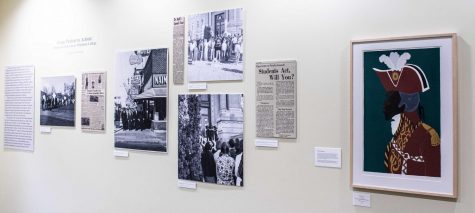Anti-violence and the Black Lives Matter movement
October 22, 2020
The 1960s Black Power activist formerly known as H. Rap Brown once said that violence is “as American as cherry pie.” Black Lives Matter protests in June and July were sites of alarming acts of violence. In Charleston, South Carolina, dozens of police officers in full riot gear came upon a peaceful protest in a public park of individuals kneeling on the ground in silence. Coming within 100 feet of the gathering, they declared the space an unlawful assembly and forcibly removed protesters that did not disperse immediately.
In Minneapolis, Minnesota, military police opened fire on and stormed a nurse’s tent where a rubber bullet wound was being treated. In Louisville, Kentucky, gallons of water and milk left to aid protesters were stolen by police officers and protected by officers in full riot gear.
In Portland, Oregon, the police department agreed to take a knee with protestors, and almost immediately after the media got their photos, they deployed gas masks among themselves and gassed the entire park. In Seattle, Washington, a 7 year old boy unrelated to protests was pepper sprayed by a police officer, as was a 9 year old girl participating in a protest.
Four months later, the movement has lost little steam. Protestors were violently mass-arrested in Seattle on Oct. 15, as well as in Portland in late September, and thousands of protesters have been arrested since June.
Black Americans have employed violence, nonviolence, marches, sit-ins, walk-outs and boycotts to challenge oppressive systems, but there is no form of Black protest that white America will sanction. As much as white people love to use Martin Luther King’s words to police people of color, it is not insignificant that his death ignited riots in over 100 cities. The Civil Rights Movement of the 1960s, despite its purportedly non-violent underpinnings, also relied heavily on armed self-defense groups like the Deacons for Defense and Justice, as well as the Black Panther Party. Violence disrupts the status quo in a way that begets a response. Disruptive political dissent has a way of spotlighting not only the flaws in the system, but the strength of those in power.
To focus on debating whether violent dissent has helped Black Americans in the “game” of politics forgets that the “game” is not just rigged but is broken. In the five decades since the passage of the Civil Rights Act of 1964, the white average wealth is 6.7 times greater than Black average wealth. Black people are 12 percent of the population, but make up 26.4 percent of people killed by law enforcement. Black drivers are 20 percent more likely to be stopped by the police than white drivers, and unarmed black civilians are nearly five times more likely to be shot and killed by police than unarmed white civilians.
Considering that an overwhelming amount of criticism of the Black Lives Matter movement surrounds the violence associated with its demonstrations, serious questions should be raised in regard to who uses to the anti-violent rhetoric. The sentiment that “violence is never the answer” should confuse most Americans in light of their long history of domestic and international terrorism on communities of color. If violence is a political language, it is the native tongue of the United States Federal Government. While the philosophy of force and violence to obtain freedom and liberation has long been popularly employed by whites, it was always explicitly denied to Black Americans.







